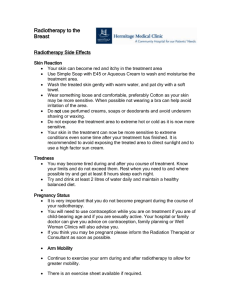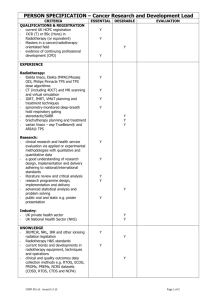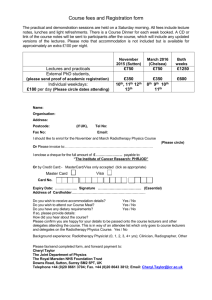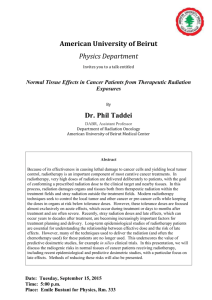optimization in external beam therapy: Part 7
advertisement
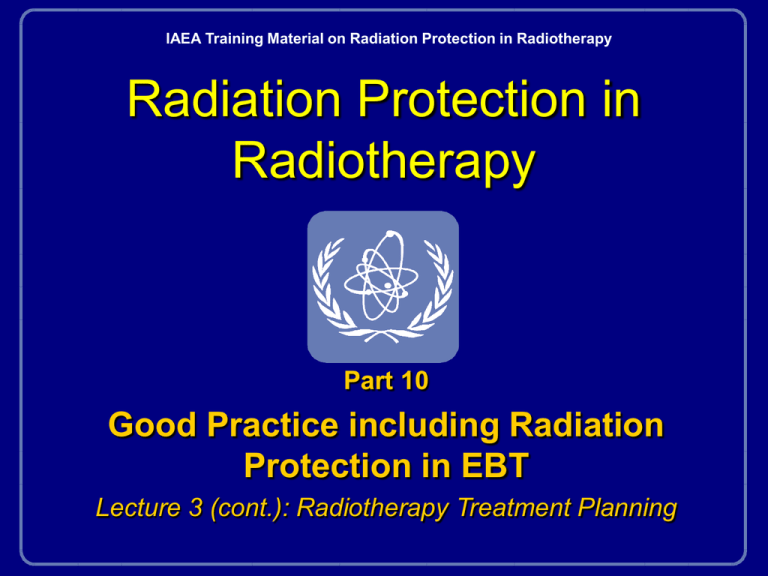
IAEA Training Material on Radiation Protection in Radiotherapy Radiation Protection in Radiotherapy Part 10 Good Practice including Radiation Protection in EBT Lecture 3 (cont.): Radiotherapy Treatment Planning C. Commissioning Complex procedure depending very much on equipment Protocols exist and should be followed Useful literature: J van Dyk et al. 1993 Commissioning and QA of treatment planning computers. Int. J. Radiat. Oncol. Biol. Phys. 26: 261-273 J van Dyk et al, 1999 Computerised radiation treatment planning systems. In: Modern Technology of Radiation Oncology (Ed.: J Van Dyk) Chapter 8. Medical Physics Publishing, Wisconsin, ISBN 0-944838-38-3, pp. 231-286. Radiation Protection in Radiotherapy Part 10, lecture 3 (cont.): Radiotherapy treatment planning 2 Acceptance testing and commissioning Acceptance testing: Check that the system conforms with specifications. Documentation of specifications either in the tender, in guidelines or manufacturers’ notes – may test against standard data (e.g. Miller et al. 1995, AAPM report 55) Subset of commissioning procedure Takes typically two weeks Commissioning: Getting the system ready for clinical use Takes typically several months for modern 3D system Radiation Protection in Radiotherapy Part 10, lecture 3 (cont.): Radiotherapy treatment planning 3 Some equipment required Scanning beam data acquisition system Calibrated ionization chamber Slab phantom including inhomogeneities Radiographic film Anthropomorphic phantom Ruler, spirit level Radiation Protection in Radiotherapy Part 10, lecture 3 (cont.): Radiotherapy treatment planning 4 Commissioning A. Non-dose related components B. Photon dose calculations C. Electron dose calculations (D. Brachytherapy - covered in part 11) E. Data transfer F. Special procedures Radiation Protection in Radiotherapy Part 10, lecture 3 (cont.): Radiotherapy treatment planning 5 A. Non-dose components Image input Geometry and scaling of Digitizer, Scans Output Text information Anatomical structure information CT numbers Structures (outlining tools, non-axial reconstruction, “capping”,…) Radiation Protection in Radiotherapy Part 10, lecture 3 (cont.): Radiotherapy treatment planning 6 Electron and photon beams Description (machine, modality, energy) Geometry (Gantry, collimator, table, arcs) Field definition (Collimator, trays, MLC, applicators, …) Beam modifiers (Wedges, dynamic wedges, compensators, bolus,…) Normalization Radiation Protection in Radiotherapy Part 10, lecture 3 (cont.): Radiotherapy treatment planning 7 B. Photon calculation tests Point doses TAR, TPR, PDD, PSF Square, rectangular and irregular fields Inverse square law Attenuation factors (trays, wedges,…) Output factors Machine settings Radiation Protection in Radiotherapy Part 10, lecture 3 (cont.): Radiotherapy treatment planning 9 Photon calculation tests (cont.) Dose distribution Homogenous Profiles (open and wedged) SSD/SAD Contour correction Blocks, MLC, asymmetric jaws Multiple beams Arcs Off axis (open and wedged) Collimator/couch rotation Radiation Protection in Radiotherapy PTW waterphantom Part 10, lecture 3 (cont.): Radiotherapy treatment planning 10 Photon calculation tests (cont.) Dose distribution Inhomogeneous Slab geometry Other geometries Anthropomorphic phantom In vivo dosimetry at least for the first patients Following the incident in Panama, the IAEA recommends a largely extended in vivo dosimetry program to be implemented Radiation Protection in Radiotherapy Part 10, lecture 3 (cont.): Radiotherapy treatment planning 11 C. Electron calculation Similar to photons, however, additional: Bremsstrahlung tail Small field sizes require special consideration Inhomogeneity has more impact It is possible to use reference data for comparison (Shui et al. 1992 “Verification data for electron beam dose algorithms” Med. Phys. 19: 623-636) Radiation Protection in Radiotherapy Part 10, lecture 3 (cont.): Radiotherapy treatment planning 12 E. Data transfer Pixel values, CT numbers Missing lines Patient/scan information Orientation Distortion, magnification All needs verification!!! Radiation Protection in Radiotherapy Part 10, lecture 3 (cont.): Radiotherapy treatment planning 13 F. Special procedures Junctions Electron abutting Stereotactic procedures Small field procedures (e.g. for eye treatment) IMRT TBI, TBSI Intraoperative radiotherapy Radiation Protection in Radiotherapy Part 10, lecture 3 (cont.): Radiotherapy treatment planning 14 Sources of uncertainty Patient localization Imaging (resolution, distortions,…) Definition of anatomy (outlines,…) Beam geometry Dose calculation Dose display and plan evaluation Plan implementation Radiation Protection in Radiotherapy Part 10, lecture 3 (cont.): Radiotherapy treatment planning 15 Typical accuracy required (examples) Square field CAX: 1% MLC penumbra: 3% Wedge outer beam: 5% Buildup-region: 30% 3D inhomogeneity CAX: 5% From AAPM TG53 Radiation Protection in Radiotherapy Part 10, lecture 3 (cont.): Radiotherapy treatment planning 16 Typical accuracy required (examples) Note: Uncertainties have two components: Dose (given in %) Location (given in mm) Radiation Protection in Radiotherapy Square field CAX: 1% MLC penumbra: 3% Wedge outer beam: 5% Buildup-region: 30% 3D inhomogeneity CAX: 5% Part 10, lecture 3 (cont.): Radiotherapy treatment planning 17 Time and staff requirements for commissioning (J Van Dyk 1999) Photon beam: 4-7 days Electron beam: 3-5 days Brachytherapy: 1 day per source type Monitor unit calculation: 0.3 days per beam Radiation Protection in Radiotherapy Part 10, lecture 3 (cont.): Radiotherapy treatment planning 18 Some ‘tricky’ issues Dose Volume Histograms - watch sampling, grid, volume determination, normalization (1% volume represents still > 10E7 cells!) Biological parameters - Tumour Control Probability (TCP) and Normal Tissue Complication Probability (NTCP) depend on the model used and the parameters which are available. Radiation Protection in Radiotherapy Part 10, lecture 3 (cont.): Radiotherapy treatment planning 19 Commissioning summary Probably the most complex task for RT physicists - takes considerable time and training Partial commissioning needed for system upgrades and modification Documentation and hardcopy data must be included Training is essential and courses are available Independent check highly recommended Radiation Protection in Radiotherapy Part 10, lecture 3 (cont.): Radiotherapy treatment planning 20 Quick Question: What ‘commissioning’ needs to be done for a hand calculation method of treatment times for a superficial X Ray treatment unit? Superficial beam HVL Percentage depth dose (may be look up table) Normalization point (typically the surface) Scatter (typically back scatter) factor Applicator and/or cone factor Timer accuracy On/off effect Other effects which may affect dose (e.g. electron contamination) Radiation Protection in Radiotherapy Part 10, lecture 3 (cont.): Radiotherapy treatment planning 22 Quality Assurance of a treatment planning system QA is typically a subset of commissioning tests Protocols: As for commissioning and: M Millar et al. 1997 ACPSEM position paper. Australas. Phys. Eng. Sci. Med. 20 Supplement B Fraas et al. 1998 AAPM Task Group 53: QA for clinical RT planning. Med. Phys. 25: 1773-1829 Radiation Protection in Radiotherapy Part 10, lecture 3 (cont.): Radiotherapy treatment planning 23 Aspects of QA (compare also part 12 of the course) Training - qualified staff Checks against a benchmark reproducibility Treatment verification QA administration Communication Documentation Awareness of procedures required Radiation Protection in Radiotherapy Part 10, lecture 3 (cont.): Radiotherapy treatment planning 24 Quality Assurance Radiation Protection in Radiotherapy Part 10, lecture 3 (cont.): Radiotherapy treatment planning 25 Quality Assurance Check prescription Radiation Protection in Radiotherapy Hand calculation of treatment time Part 10, lecture 3 (cont.): Radiotherapy treatment planning 26 Frequency of tests for planning (and suggested acceptance criteria) Commissioning and significant upgrades Annual: See above MU calculation (2%) Reference plan set (2% or 2mm) Scaling/geometry input/output devices (1mm) Monthly Check sum Some reference test sets Radiation Protection in Radiotherapy Part 10, lecture 3 (cont.): Radiotherapy treatment planning 27 Frequency of tests (cont.) Weekly Each time system is turned on Input/output devices Check sum (no change) Each plan CT transfer - orientation? Monitor units - independent check Verify input parameters (field size, energy, etc.) Radiation Protection in Radiotherapy Part 10, lecture 3 (cont.): Radiotherapy treatment planning 28 Treatment planning QA summary Training most essential Staying alert is part of QA Documentation and reporting necessary Treatment verification in vivo can play an important role Radiation Protection in Radiotherapy Part 10, lecture 3 (cont.): Radiotherapy treatment planning 29 Quick Question: How much time should be spent on treatment planning QC? Staff and time requirements (source J. Van Dyk et al. 1999) Reproducibility tests/QC: 1 week per year In vivo dosimetry: about 1 hour per patient - aim for about 10% of patients Manual check of plans and monitor units: 20 minutes per plan Radiation Protection in Radiotherapy Part 10, lecture 3 (cont.): Radiotherapy treatment planning 31 QA in treatment planning The planning system Plan of a patient QA of the system Radiation Protection in Radiotherapy QA of the plan Part 10, lecture 3 (cont.): Radiotherapy treatment planning 32 QC of treatment plans Treatment plan: Documentation of treatment set-up, machine parameters, calculation details, dose distribution, patient information, record and verify data Radiation Protection in Radiotherapy Consists typically of: Treatment sheet Isodose plan Record and Verify entry Reference films (simulator, DRR) Part 10, lecture 3 (cont.): Radiotherapy treatment planning 33 QC of treatment plans Check plan for each patient prior to commencement of treatment Plan must be Complete from prescription to set-up information and dose delivery advise Understandable by colleagues Document treatment for future use Radiation Protection in Radiotherapy Part 10, lecture 3 (cont.): Radiotherapy treatment planning 34 Who should do it? Treatment sheet checking should involve senior staff It is an advantage if different professions can be involved in the process Reports must go to clinicians and the relevant QA committee Radiation Protection in Radiotherapy Part 10, lecture 3 (cont.): Radiotherapy treatment planning 35 Example for physics treatment sheet checking procedure 1. 2. 3. 4. 5. 6. 7. 8. 9. 10. 11. 12. 13. 14. 15. 16. 17. Check prescription (energy/dose/fractionation is everything signed ?) Check prescription and calculation page for consistency: Isocentric (SAD) or fixed distance (SSD) set-up ? Are all necessary factors used? Check both,dose/fraction and number of fractions. Check normalisation value (Plan or data sheets). Check outline, separation and prescription depth. Turn to treatment plan: Does it look ok ? Outline ? Bolus ? Isocentre placement and normalisation point ? Any concerns regarding the use of algorithms near surfaces or inhomogeneities? Would you expect problems in planes not shown ? Prescription ? Check and compare with treatment sheet calculation page: treatment unit and type, field names, weighting, wedges, blocks, field size (FS), focus surface distance (FSD), Tissue Air Ratio (TAR) (if isocentric treatment) - is this consistent with entries in treatment log page? Electrons only: … Photons only: … Check shadow tray factor, wedge factor. Are any other attenuation factors required (e.g. couch, headrest, table tray...) ? Check inverse square law factor (in electron treatments: is the virtual FSD appropriate?) Calculate monitor units. Is time entry ok ? Check if critical organ (e.g. spinal cord, lens, scrotum) dose or hot spot dose is required. If so, is it calculated correctly ? Suggest in vivo dosimetry measurements if appropriate. Sign calculation sheet (if everything is ok). Compare results on calculation page with entries in treatment log. Check diagram and/or set up description: is there anything else worth to consider ? Sign top of treatment sheet (specify what parts where checked if not all fields were checked). Contact planning staff if required. Sign off physics log book. Radiation Protection in Radiotherapy Part 10, lecture 3 (cont.): Radiotherapy treatment planning 36 Example for physics treatment sheet checking procedure 1. Check prescription (energy/dose/fractionation is everything signed ?) 2. Check prescription and calculation page for consistency: Isocentric (SAD) or fixed distance (SSD) set-up ? Are all necessary factors used? Check both,dose/fraction and number of fractions. 3. Check normalisation value (Plan or data sheets). 4. Check outline, separation and prescription depth. 5. Turn to treatment plan: Does it look ok ? Outline ? Bolus ? Isocentre placement and normalisation point ? Any concerns regarding the use of algorithms near surfaces or inhomogeneities? Would you expect problems in planes not shown ? Prescription ? Radiation Protection in Radiotherapy Part 10, lecture 3 (cont.): Radiotherapy treatment planning 37 Example for physics treatment sheet checking procedure (cont.) 6. 7. 8. 9. 10. 11. 12. Check and compare with treatment sheet calculation page: treatment unit and type, field names, weighting, wedges, blocks, field size (FS), focus surface distance (FSD), Tissue Air Ratio (TAR) (if isocentric treatment) - is this consistent with entries in treatment log page? Electrons only: … Photons only: … Check shadow tray factor, wedge factor. Are any other attenuation factors required (e.g. couch, headrest, table tray...) ? Check inverse square law factor (in electron treatments: is the virtual FSD appropriate?) Calculate monitor units. Is time entry ok ? Check if critical organ (e.g. spinal cord, lens, scrotum) dose or hot spot dose is required. If so, is it calculated correctly ? Radiation Protection in Radiotherapy Part 10, lecture 3 (cont.): Radiotherapy treatment planning 38 Example for physics treatment sheet checking procedure (cont.) 13. Suggest in vivo dosimetry measurements if appropriate. Sign calculation sheet (if everything is ok). 14. Compare results on calculation page with entries in treatment log. 15. Check diagram and/or set up description: is there anything else worth to consider ? 16. Sign top of treatment sheet (specify what parts where checked if not all fields were checked). 17. Contact planning staff if required. Sign off physics log book. Radiation Protection in Radiotherapy Part 10, lecture 3 (cont.): Radiotherapy treatment planning 39 Treatment plan QA summary Essential part of departmental QA Part of patient records Multidisciplinary approach Radiation Protection in Radiotherapy Part 10, lecture 3 (cont.): Radiotherapy treatment planning 40 Quick Question: What advantages has a multidisciplinary approach to QC of treatment plans? Did we achieve the objectives? Understand the general principles of radiotherapy treatment planning Appreciate different dose calculation algorithms Be able to apply the concepts of optimization of medical exposure throughout the treatment planning process Appreciate the need for quality assurance in radiotherapy treatment planning Radiation Protection in Radiotherapy Part 10, lecture 3 (cont.): Radiotherapy treatment planning 42 Overall Summary Treatment planning is the most important step towards radiotherapy for individual patients as such it is essential for patient protection as outlined in BSS Treatment planning is growing more complex and time consuming Understanding of the process is essential QA of all aspects is essential Radiation Protection in Radiotherapy Part 10, lecture 3 (cont.): Radiotherapy treatment planning 43 Any questions? Question: Please label and discuss the following processes in external beam radiotherapy treatment. Question: Diagnostic tools 1 Patient 2 4 6 3 5 Treatment planning Radiation Protection in Radiotherapy Treatment unit Part 10, lecture 3 (cont.): Radiotherapy treatment planning 46
